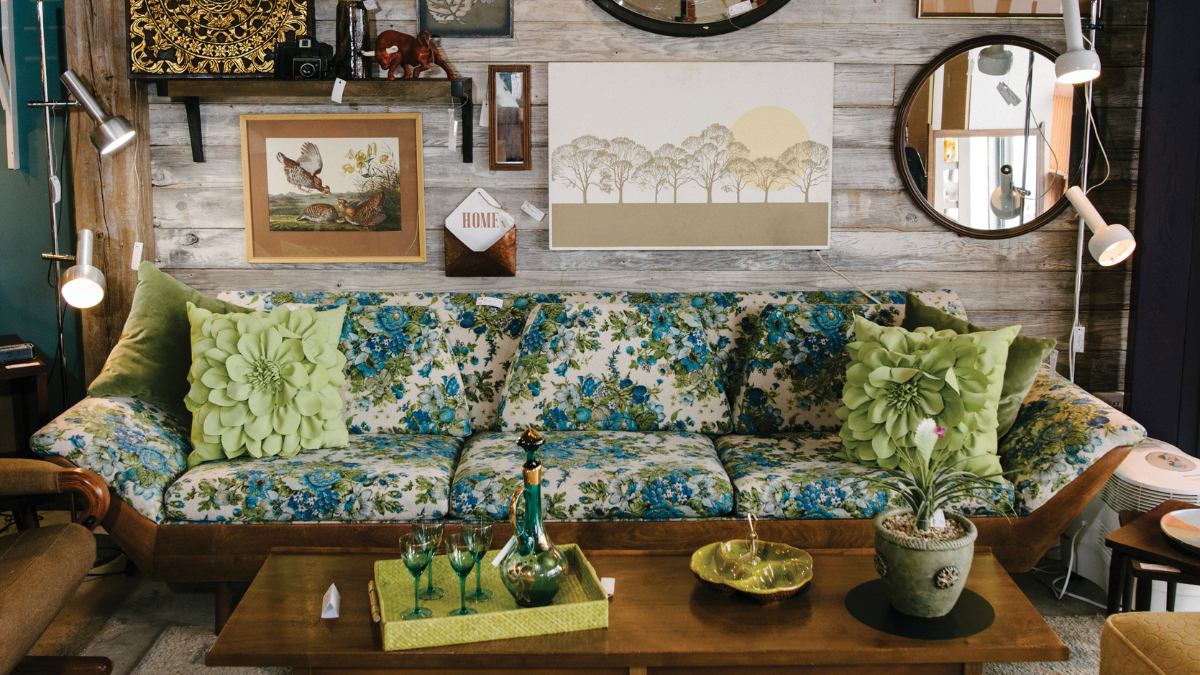By Shelby Deering
We asked three area vintage pros to dispense their best words of wisdom for shopping pieces, learning as you go and weaving finds into your home.
Make it Personal
When it comes to shopping for antiques and vintage items, one thing’s for sure: it has to appeal to your tastes and personality. Who cares if it’s on-trend or not? If you love it, that’s all that matters.
“I tend to look for something that makes me smile,” says Therese Turnbaugh, who co-owns Walworth’s Angelus Home & Garden with her sister, Jeannene Clark. “It’s usually a particular color or something that sparks a good memory for me.”
Philip Sassano, principal at The Design Coach, LLC, says that vintage items have a unique ability to connect with people as if they’re “soaked in nostalgia.”
And Tereasa Surratt, co-owner of Elkhorn’s Camp Wandawega, has a simple question you can ask yourself: Does it speak to you? She says, “If it makes your heart sing when you first see it, then grab it up.”
Do Your Homework
While it’s perfectly acceptable to snatch up whatever item speaks to your soul, it can help to be armed with a little knowledge.
Surratt recommends having your smartphone handy when shopping to do “fast research” on something, to detect whether something is a knock-off, to price-compare online or just to see how “common” an item is.
You can also chat up vendors, sellers and proprietors and learn more about a piece that “stops you in your tracks,” as Turnbaugh puts it.
“Many times, the seller will give you a history or details that will strike a chord and you will not want to leave it behind,” she says. Once you get it home, you can further research it.
Also, shopping regularly can build up your know-how.
“If you shop the flea markets, you’ll begin to know the prices as well,” Turnbaugh says. “Just because there is a price tag on something doesn’t necessarily mean that’s the value.”
She adds that there is plenty of information on the internet to figure out the general value of something.
Authenticate Items
If you really start to get into vintage shopping, you may want to start authenticating items — reproductions and knock-offs just won’t do for your curated collection.
“This is getting more difficult every year as quality reproductions are made available and often passed off as authentically vintage,” Sassano points out. He suggests limiting your purchases to qualified and experienced dealers.
“I love to buy from established collectors and longtime salvage soldiers who can share their personal journey or discovery of a particular item,” he says.
Turnbaugh advises being on the lookout for imprinted trademarks or stamps on items (this is where that homework comes in). Once you get familiar with particular makes, designers or manufacturers, you’ll be able to spot these pieces a mile away.
“There are professional appraisers who can help authenticate an item if the buyer doesn’t feel confident researching it,” she says.
Have Spots in Mind for Pieces
Although vintage shopping, at its core, should be a carefree venture filled with flights of fancy, Surratt suggests being honest: “Do you have a spot for it? If you can’t picture it in a specific place, then you probably don’t need it.”
Turnbaugh agrees that antiques should each have a place.
“If I was to start a vintage dishware collection, I’d want a display cabinet just for that,” she muses. “I wouldn’t throw my vintage items in with my everyday dishes. Same with furniture. If it’s a single piece, make sure it’s in scale with the other furnishings around it.”
Where To Shop
The Lake Geneva area has many options for antique and vintage shopping.
- Angelus Home & Garden, angelushome.com
- Elkhorn Antique Flea Market, elkhornantiquefleamarket.com
- Lake Geneva Antique Mall, lakegenevaantiquemall.com
- Maple Park Antiques of Lake Geneva, facebook.com/people/Maple-Park-Antiques-of-Lake-Geneva
- My Sister & Me, mysisterandmevintage.com
- Tique Furnishings, tiquefurnishings.com





